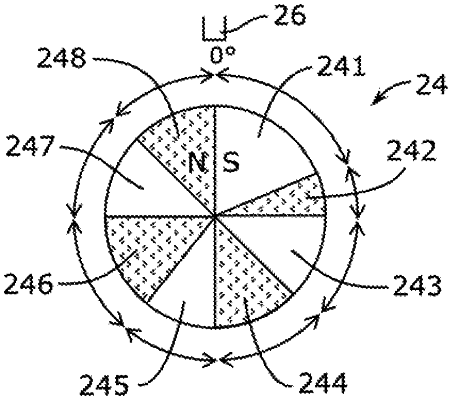| CPC G01D 5/24476 (2013.01) [G01D 5/142 (2013.01); G01D 5/24466 (2013.01); G01D 5/2457 (2013.01); G01P 3/487 (2013.01)] | 15 Claims |

|
1. A method for detecting an absolute angular position or an absolute angular travel of a rotating member with respect to a reference member about an axis of rotation, using a measuring device comprising a multipole annular encoder comprising N pairs of poles that is fastened to the rotating member and a sensor that is fixed with respect to the reference member, each pair of the poles comprising a pole of north type and a pole of south type, the N pairs of poles forming, over one revolution, an alternation of poles of north type and of south type, the alternation of poles not being distributed regularly around the axis of rotation, the method comprising:
detecting with the sensor a sequence of successive transitions, each transition characteristic of a passage of the poles of the alternation of poles in front of the sensor;
for a plurality of the transitions, each of which is referred to as a tested transition, and preferably for all the transitions of the sequence of successive transitions, determining at least one characteristic time of the tested transition, equal to a time separating the tested transition from another transition of the sequence of successive transitions, the other transition being immediately adjacent to the tested transition in the sequence of successive transitions or being separated from the tested transition by a predetermined number of successive transitions of the sequence of successive transitions, the predetermined number comprised between 1 and 2N−2;
determining a plurality of moving complete rotation times each associated with one of the transitions extracted from the sequence of successive transitions and each equal to a time separating the extracted transition from a preceding transition of order 2N of the sequence of successive transitions, and an estimated complete rotation time, which is dependent on one or more of the moving complete rotation times; and
computing for each tested transition at least one characteristic angle of the tested transition, which angle is proportional to a ratio between the characteristic time of the tested transition and the estimated complete rotation time.
|